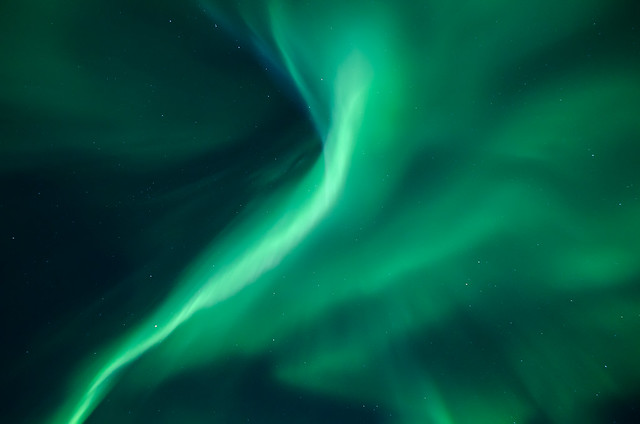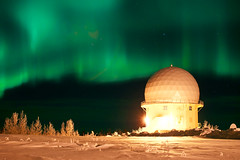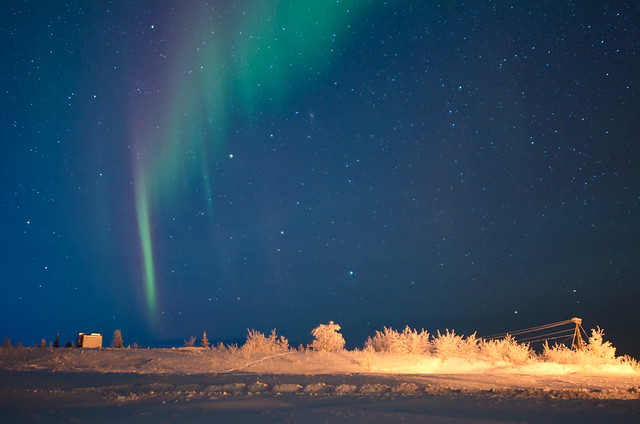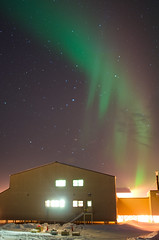
One of the ways researchers study auroras is by launching sounding rockets which carry instruments to measure things like electric and magnetic fields, currents, or particle density or energy. This provides a direct measurement of the actual conditions in the aurora, rather than just inferring the conditions using data from cameras on the ground or satellites at much higher altitudes. Sunday I returned to Fairbanks from participating in just such a launch. If you want to know more about the rocket, you should read Ian's post. Ian is a grad student at the University of New Hampshire who spent the previous ~1.5 weeks with me in the Arctic circle waiting for this rocket to fly over. Which is really the thing I'm getting at here: I spent the last ~1.5 weeks in the Arctic circle, manning equipment and watching auroras.
We stayed at a cold war era early warning radar site about a mile outside the town of Fort Yukon, a few miles inside the Arctic circle. Crossing 8 miles over the Arctic circle is kind of a non-event - It's like crossing the border into Canada: Okay, you take a picture of the sign, and get excited and stuff, but it's all just pretend, nothing really changes about the scenery. Though the Arctic circle is more of a 'real' boundary than a state or country border, it's not like you're instantly on the windswept tundra hiding from polar bears. But anyways...
We (Ian and I) arrived in Fort Yukon via small plane (did I mention it's not connected to the road system?) on the morning of Friday the 10th. We got our bags and met up with our ride to the station. A brief tour of town on the way, and then it was down to business: Unpacking and installing 13 cases and 3 wooden crates (!) of camera gear. Got most of it together Friday night and Saturday morning, with some final touches after first use. A third researcher, Hans, showed up Saturday to complete our crew. We then sat around with no visibility under cloudy skies until Tuesday the 14th, when we had clear skies and a fantastic aurora show. We decided not to launch that night because the aurora wasn't exactly the kind we were looking for, and we still had some equipment problems to wring out, so we went outside to watch. It was Ian's first aurora, and it was a damn good one.



I shot video too: Have some Valentine's Day auroras:
After that, we had several more nights of clouds and/or low activity. The daily routine was to start up computers and cameras at 7pm for a launch window that opened at 8pm, then surf the internet / read a book / play a game until the window closed at 2am. Then sleep until lunch, do whatever maintenance needs done, and start again. On Saturday the 18th I commented that 'tonight is the night', as the sky was clear and the indicators looked good, and I was right. Another very nice aurora:


And this time we launched the rocket! Liftoff at 05:41UT, or 08:41pm local time. The rocket reached 325km altitude, and the whole event was over in 10 minutes. I didn't even get to see it because I was inside pointing the science cameras. But I had my own cameras running again, so here's the aurora we launched into. My favorite is the blob of red aurora that appears above the building:
A Japanese group has some all-sky cameras running at Poker, and they got a shot of liftoff:

Credit for that shot to Ryuho Kataoka.
Here's a few more photos of the rocket as it flew up, but they're in full resolution, so I'll link rather than embed:
From Mark Conde
From Craig Heinselman
Here's a mapped projection of the Fort Yukon all sky camera. The time at the top is universal time: The rocket launch was at 05:41 and the flight took around 10 minutes. The dotted line shows the rough trajectory of the rocket. You can click the play button at the bottom.
I know, I know: HAAAAAAAAAARP!!!!11
And there has been some press coverage:
CNN
MSNBC PhotoBlog
Associated Press
Huffington Post
Anchorage Daily News
Fairbanks News-Miner
A film crew from the Discovery Channel was present at Poker to film the launch. I was 100 miles away from there. I assume they were successful. I think it will be used as part of the english release of the Cosmic Shore program coming out in spring, but I totally just made that up, so we'll see.
And then it was all over. Back to regular life in civilization, or as regular and civilized you consider a log cabin with no running water to be, anyway. Until next time.
I found out that it was actually a a camera crew from Discovery Channel Canada...so womp womp.
ReplyDeleteThose points in the video where the aurora gets so bright that everything just glows green...breathtaking.
ReplyDelete